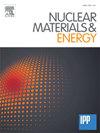Investigation of the interaction of deuterium with Sn73Li27 tin-lithium alloy
IF 2.3
2区 物理与天体物理
Q1 NUCLEAR SCIENCE & TECHNOLOGY
引用次数: 0
Abstract
The SnLi alloy has good prospects to be used as a material of intra-chamber elements of fusion facilities, as it has a number of advantages over pure lithium. The results of a series of experiments on deuterium adsorption/desorption by a Sn73Li27 alloy sample are presented. To prepare an alloy sample with the required tin and lithium content, a technique was developed and a special experimental device was constructed. An ampoule device was manufactured to conduct a series of experiments to study sample saturation with deuterium and desorption of deuterium and deuterium-containing molecules from it. Saturation was carried out at alloy temperatures of 650, 600, 550, 500 and 450 °C. TDS experiments were carried out at 20 °C/min. The possible mechanism of deuterium dissolution and release from the tin-lithium alloy was considered and temperature dependences of the effective deuterium solubility constant KS in the tin-lithium alloy were calculated within the framework of the proposed mechanism. The temperature dependence of the Sieverts’ constant for the test sample in the temperature range of 500–650 °C was determined as
氘与Sn73Li27锡锂合金相互作用的研究
与纯锂相比,SnLi合金具有许多优点,在聚变装置内腔元件材料中具有良好的应用前景。本文介绍了Sn73Li27合金样品对氘的吸附/解吸的一系列实验结果。为了制备符合要求的锡和锂含量的合金样品,开发了一种工艺并构建了专用的实验装置。制作了安瓿装置,进行了一系列实验,研究了样品中氘的饱和以及氘和含氘分子的解吸。在650、600、550、500和450℃的合金温度下进行饱和。TDS实验在20°C/min下进行。考虑了氘从锡锂合金中溶解和释放的可能机理,并在提出的机理框架内计算了锡锂合金中有效氘溶解度常数KS的温度依赖性。测定样品在500-650℃温度范围内Sieverts常数的温度依赖性为KST=3.6·106∙exp-32400(J)RT∙Pa12。
本文章由计算机程序翻译,如有差异,请以英文原文为准。
求助全文
约1分钟内获得全文
求助全文
来源期刊

Nuclear Materials and Energy
Materials Science-Materials Science (miscellaneous)
CiteScore
3.70
自引率
15.40%
发文量
175
审稿时长
20 weeks
期刊介绍:
The open-access journal Nuclear Materials and Energy is devoted to the growing field of research for material application in the production of nuclear energy. Nuclear Materials and Energy publishes original research articles of up to 6 pages in length.
 求助内容:
求助内容: 应助结果提醒方式:
应助结果提醒方式:


